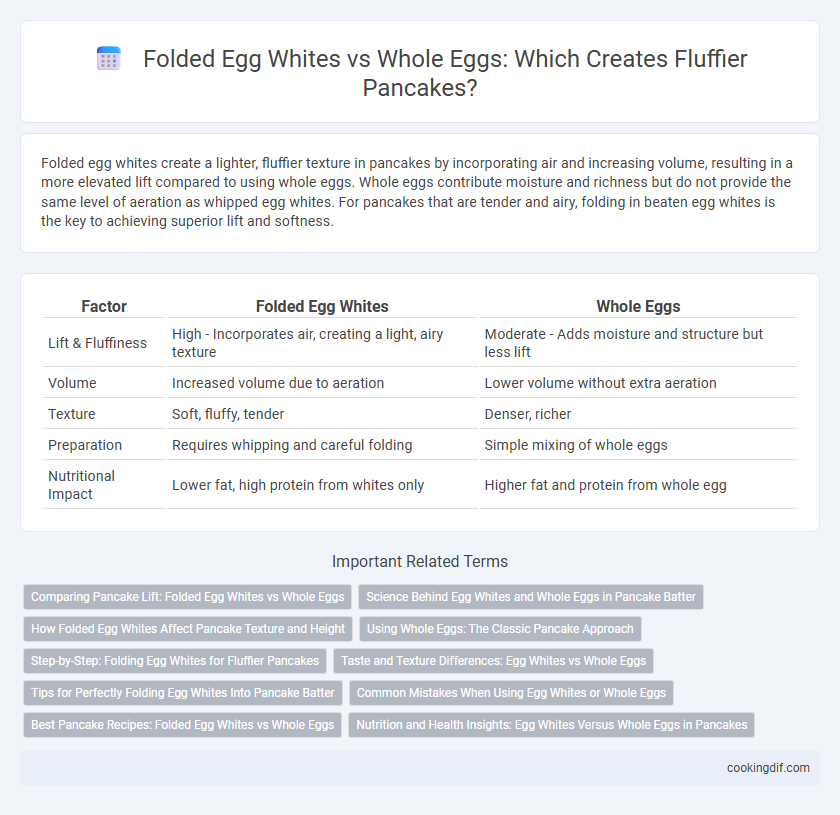Folded egg whites create a lighter, fluffier texture in pancakes by incorporating air and increasing volume, resulting in a more elevated lift compared to using whole eggs. Whole eggs contribute moisture and richness but do not provide the same level of aeration as whipped egg whites. For pancakes that are tender and airy, folding in beaten egg whites is the key to achieving superior lift and softness.
Table of Comparison
| Factor | Folded Egg Whites | Whole Eggs |
|---|---|---|
| Lift & Fluffiness | High - Incorporates air, creating a light, airy texture | Moderate - Adds moisture and structure but less lift |
| Volume | Increased volume due to aeration | Lower volume without extra aeration |
| Texture | Soft, fluffy, tender | Denser, richer |
| Preparation | Requires whipping and careful folding | Simple mixing of whole eggs |
| Nutritional Impact | Lower fat, high protein from whites only | Higher fat and protein from whole egg |
Comparing Pancake Lift: Folded Egg Whites vs Whole Eggs
Folded egg whites create a lighter, airier pancake texture by trapping more air bubbles, resulting in greater lift compared to whole eggs. Whole eggs contribute both structure and moisture but produce a denser pancake with less height. For maximum pancake lift, incorporating carefully folded egg whites is the preferred technique over using whole eggs alone.
Science Behind Egg Whites and Whole Eggs in Pancake Batter
Egg whites contain proteins that, when whipped, trap air and create a stable foam, contributing significantly to pancake lift and a lighter texture. Whole eggs provide fat and emulsifiers that enhance flavor and moisture but result in denser pancakes compared to those made with folded egg whites. The science behind pancake batter shows that incorporating folded egg whites increases volume and fluffiness by improving aeration and structural integrity.
How Folded Egg Whites Affect Pancake Texture and Height
Folding whipped egg whites into pancake batter increases air incorporation, resulting in a lighter, fluffier texture and greater height. Unlike whole eggs, which provide structure and moisture, folded egg whites create lift by trapping air bubbles that expand during cooking. This technique enhances pancake volume and tenderness, producing a more delicate and airy final product.
Using Whole Eggs: The Classic Pancake Approach
Using whole eggs in pancake batter provides a balanced combination of protein and fat that contributes to a tender, moist texture while maintaining sufficient structure for lift. The yolks add richness and flavor, while the whites help with aeration but are not whipped separately, resulting in a denser but reliably fluffy pancake. This classic method ensures consistent rise and a soft crumb, favored in traditional pancake recipes.
Step-by-Step: Folding Egg Whites for Fluffier Pancakes
Folding whipped egg whites into pancake batter instead of using whole eggs results in significantly fluffier and lighter pancakes due to increased air incorporation. Begin by whipping egg whites to soft peaks, then gently fold them into the batter in three increments, using a spatula to maintain airiness without overmixing. This step-by-step folding technique ensures maximum lift and a tender pancake texture.
Taste and Texture Differences: Egg Whites vs Whole Eggs
Using folded egg whites in pancakes creates a lighter, airier texture with a delicate crumb, enhancing the fluffiness and resulting in a subtle, clean taste that highlights other ingredients. Whole eggs contribute a richer, denser pancake with a slightly creamy mouthfeel and a pronounced egg flavor that deepens the overall taste profile. The difference in protein structure between whipped egg whites and whole eggs significantly influences the pancake's rise and texture, making egg whites ideal for lift without added richness.
Tips for Perfectly Folding Egg Whites Into Pancake Batter
Folding egg whites into pancake batter creates a lighter, fluffier texture by incorporating air, whereas whole eggs provide density and moisture. Gently fold whipped egg whites using a spatula with slow, sweeping motions to retain the air bubbles and avoid deflating the mixture. Ensure the egg whites are whipped to stiff peaks before folding for maximum lift and a perfectly airy pancake stack.
Common Mistakes When Using Egg Whites or Whole Eggs
Using folded egg whites instead of whole eggs often leads to overbeating, which can cause the pancake batter to become too airy and collapse during cooking. Common mistakes include not folding egg whites gently into the batter, resulting in deflated mixture and dense pancakes. When using whole eggs, overmixing the batter develops gluten, producing tough, chewy pancakes rather than fluffy ones.
Best Pancake Recipes: Folded Egg Whites vs Whole Eggs
In the best pancake recipes, folded egg whites create a lighter, airier texture compared to whole eggs, which yield a denser, richer batter. The technique of folding whipped egg whites into the batter introduces volume and lift, enhancing fluffiness without compromising flavor. Whole eggs provide stability and moisture, but for maximum rise and softness, incorporating folded egg whites is preferred for fluffy pancakes.
Nutrition and Health Insights: Egg Whites Versus Whole Eggs in Pancakes
Folded egg whites in pancakes contribute to a lighter, fluffier texture by incorporating air without adding extra fat or cholesterol, making them a healthier option for low-calorie diets. Whole eggs provide more nutrients such as vitamins A, D, E, B12, and essential fatty acids, but also increase saturated fat and cholesterol content, impacting heart health. Choosing egg whites over whole eggs in pancakes supports lower calorie intake and reduced cholesterol, while whole eggs offer a richer nutrient profile that benefits overall nutritional balance.
Folded egg whites vs whole eggs for pancake lift Infographic

 cookingdif.com
cookingdif.com